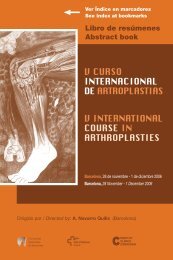Notas / Notes - Active Congress.......
Notas / Notes - Active Congress.......
Notas / Notes - Active Congress.......
Create successful ePaper yourself
Turn your PDF publications into a flip-book with our unique Google optimized e-Paper software.
JUEVES / THURSDAY<br />
134<br />
motion, absence of inflammatory arthritis or diffuse synovitis<br />
and the absence of severe instability with relatively well<br />
maintained range of motion. Significant instability should<br />
be managed prior to procedures directed to managing the<br />
cartilage deterioration, but most procedures directed to<br />
isolated uni-compartmental disease assume that the knee<br />
is intrinsically stable .<br />
UNICONDYLAR KNEE ARTHROPLASTY<br />
In general arthroplasty, including unicondylar knee arthroplasty<br />
is most appropriate for older, more sedentary patients with<br />
true isolated uni-compartmental tibio-femoral arthritis. Patients<br />
with isolated uni-condylar osteonecrosis with reasonable<br />
amounts of healthy underlying bone to support the component<br />
are also excellent candidates. Optimal results are obtained<br />
in non-obese patients without patellofemoral symptoms who<br />
have functioning anterior and posterior cruciate ligaments<br />
and range of motion greater than 120 degrees. Minor degrees<br />
of patello-femoral symptoms and less range of motion may<br />
be considered, but in general the isolated re-surfacing of the<br />
joint will not improve these findings. Minimal and passively<br />
correctable deformity are important pre-requisites for optimum<br />
results. Some consider that early arthritis isolated to the<br />
antero-medial aspect of the joint is the ideal indication for<br />
this procedure. In this setting the presence of a normal<br />
postero-medial compartment prevents medial collateral ligament<br />
contracture and renders ligament releases unnecessary.<br />
More severe involvement of the medial com-partment leads<br />
to contracture of the ligament and may require some degree<br />
of release to appropriately balance the joint but more than<br />
15 degrees of varus is considered the upper limit of acceptable<br />
deformity. Additionally the patient should not exhibit more<br />
than one centimeter of medial-lateral translation, this degree<br />
of instability precludes the likelihood of a durable result with<br />
uni-compartmental arthroplasty.<br />
Contraindications for uni-compartmental arthroplasty would<br />
include tri-compartmental or inflammatory arthritis of the<br />
knee. Significant patello-femoral symptoms and greater than<br />
Outerbridge grade 2 chondrosis of the patellofemoral or contralateral<br />
compartments as determined intra-operatively<br />
would also be contra-indications. Clinically relevant findings<br />
of range of motion less than 90 degrees, flexion contracture<br />
more than 10 degrees and deformity of more than 10 degrees<br />
of varus or15 degrees of valgus would favor total knee arthroplasty.<br />
Deficiency of the anterior or posterior cruciate ligaments,<br />
and certainly clinical evidence of any medial or lateral<br />
ligamentous instability would also contra-indicate UKA.<br />
Less rigid contra-indications include the desire to return to<br />
strenous activities involving running, high impact loading and<br />
high torque load, obesity as well as unrealistic expectations<br />
from surgical intervention. This would include patients with<br />
fibromyalgia or those who have responded poorly to multiple<br />
previous interventions.<br />
TOTAL KNEE ARTHROPLASTY<br />
Total knee arthroplasty is indicated for patients with osteoarthritis<br />
of the knee who have failed non-operative treatment<br />
and are not considered to be a good candidate for one of<br />
the alternative procedures previously mentioned. The majority<br />
of patients have arthritis affecting two compartments of the<br />
knee although good results have been reported for the treatment<br />
of older patients with isolated patello femoral arthritis.<br />
Excellent long-term results have been reported with survivorship<br />
exceeding 90% at a follow-up of more than 20 years<br />
in one recently reported series. Additional evidence indicate<br />
that patients may obtain higher levels of physical function<br />
after TKA than do patients who have undergone osteotmy.<br />
Unicompartmental Arthroplasty versus Total Knee Arthroplasty<br />
In our experience, it is most common to have to decide between<br />
total knee and unicondylar arthroplasty than between<br />
high tibial osteotomy and unicompartmental arthroplasty.<br />
Deciding between these two options can be difficult. The<br />
selection criteria for unicompartmental arthroplasty is much<br />
more exacting than for total knee arthroplasty and thus the<br />
results may not be as predictable as total knee arthroplasty<br />
for many surgeons. Specifically, it is unclear how much radiological<br />
or clinical involvement of the other compartments<br />
is acceptable and the surgeon must carefully judge how<br />
much tolerance a particular patient may have for persistent<br />
pain from the other compartments of the joint that have not<br />
been resurfaced.





